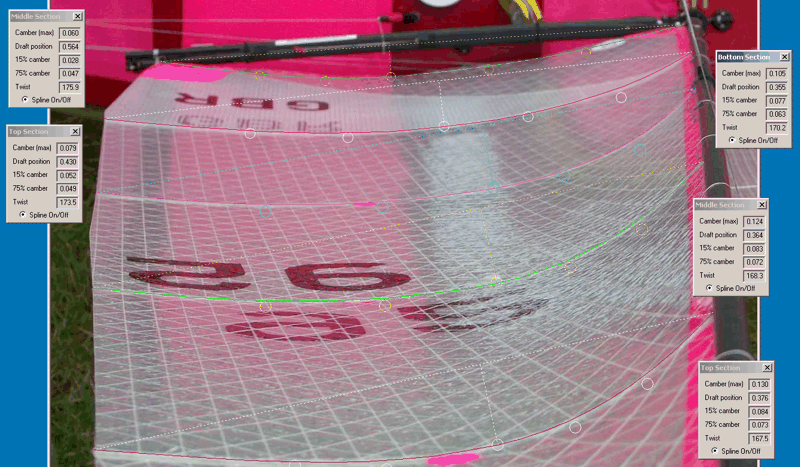Eastbourne 2007
The Eastbourne club hosted the two day 2007 RA Nationals. Conditions were
wet, grey, and breezy for much of day 1 and half of day 2. Wind was
sometimes above No.1 rig, but these were gusts and the fleet soon abandoned its
No.2 rigs, opting to live with the occasional loss of control rather than the
more likely loss of drive and places in-between times. The club ran a very
well-paced event, and even with three fleets we managed 16 races -- excellent
going. Princess lake provided enough space for the A, though setting a
properly biased start line and a first beat with more than one tack sometimes
proved difficult. Despite the odd threat of a hearing, all protests were
settled on the water and sailing was very largely fair and in the spirit of
sportsmanship.
It was my new Sword's first time on the water in serious competition. Named "Marie II" in honour of my long-time sponsor, she was completed by SAILSetc late in 2006, but sat in my garage for half a year while the day job took priority.
I took most of the first day finding her groove and getting used to her handling characteristics. Wind was right at the top of, and sometimes beyond, No.1 rig, and she showed strong weather helm that took some time to manage. A very sad incident in the afternoon saw a collision between Marie II and another boat. I was running on port tack in a sudden fierce gust and found I was unable to avoid
Terry Colson's boat which had just rounded the leeward mark and was beating on starboard. The outcome was a very large hole, and I retired from the race. Terry accepted my apologies and my offer that he should have his boat repaired professionally at my expense.
At the front of the fleet, David Hollom's "Sea Biscuit" design was enjoying an excellent run in the hands of Derek Priestley, with Peter Wiles sailing his latest "Sweet" in close pursuit. Ken Binks sailing his Sword
was also in the thick of it, and their final placings (in that order) were only
decided on the last race of the last day.
Peter continues to showcase his very nice RA fittings, a radial arm jib pivot, and an adjustable mainsail leech. More than once, we were neck and neck on a beat, and then Peter did something with his leech adjustment and eased ahead by being able to point higher for several
boat lengths.

Wiles boom fitting for leech control

Wiles boom fitting for leech control

Wiles radial arm fitting
I took a couple of sail photos of my main to compare with Peter's main. It was interesting to see how full his sail was by comparison.

PJSails (92) mainsail

SAILSetc (105) mainsail
Two boats to the Venom design from AUS were in the hands of Trevor Binks and David Munro. David enjoyed good results in the first races,
winning two A heats, but was unable to continue his early form, while Trevor struggled during the event, unable to convert some good starts and good tactical positions into final results.
I managed to find some balance in Marie II, and discovered I was sailing a very fast boat. I managed a couple of wins in A heat, and might have done even better if I hadn't hit the pin end of the line on five successive starts and emerged from the start area in last place every time!
A talking point of the event was the very curious stern of Clive Tappenden's Sweet. It turned out that this was a demonstration of an interesting issue in the rules, which allowed an extra 150 sq.in. of sail because the boat escaped any QBL penalty. While the extra sail area seemed very welcome from time to time, it also seemed that the resulting overhang was not sufficiently well faired-in, and the boat didn't show its promise in actual results. Much discussion of the QBL "cheat" failed to find a consensus on future direction for the Class Rule. (I put QBL "cheat" in quotes, because it is not in fact a cheat
at all; it is a perfectly legitimate exploitation of a rule which now requires attention.)

QBL "cheat"
Should the rule be changed, or should it be left alone? Unfortunately, there is not a viable Owners' or Class Association to address the question.
Update 1: Shortly after the event, the measurement certificate
for this boat was withdrawn. Not because of the extended transom as such,
but because it seems that the join of the transom to the hull fails to meet the
requirement of Class Rule 3.3.3, in that the hollow created by the join is
clearly greater than 2mm.
Update 2: Gordon Trower sent me a message reminding me that the
aft QBL points were the subject of an official RSD Interpretation a few years
ago.
"It would appear that the aft Quarter Beam points are located on the
transom (or upper surface of the hull depending upon definition). I sought
an interpretation in 2005 about this possibility on the basis that when the
transom is low to the water and moderately broad, placement other than on
the transom is not feasible. Discussion was wide and thorough. The published
interpretation
made on 23.12.05 indicated that the transom is part of the hull and so
indeed the aft QB points may be located on the transom. However the
interpretation also drew attention to item 3.3.3, the rule that imposes a
2mm restriction on the depth of hollows in the topsides, excluding the
portion within 10mm of the sheerline and forward of the forward end of the
waterline (item 3.3.3 in the A class rules). Comment was made that this
restriction, it follows, applies to the transom."
2010-04-05 | 